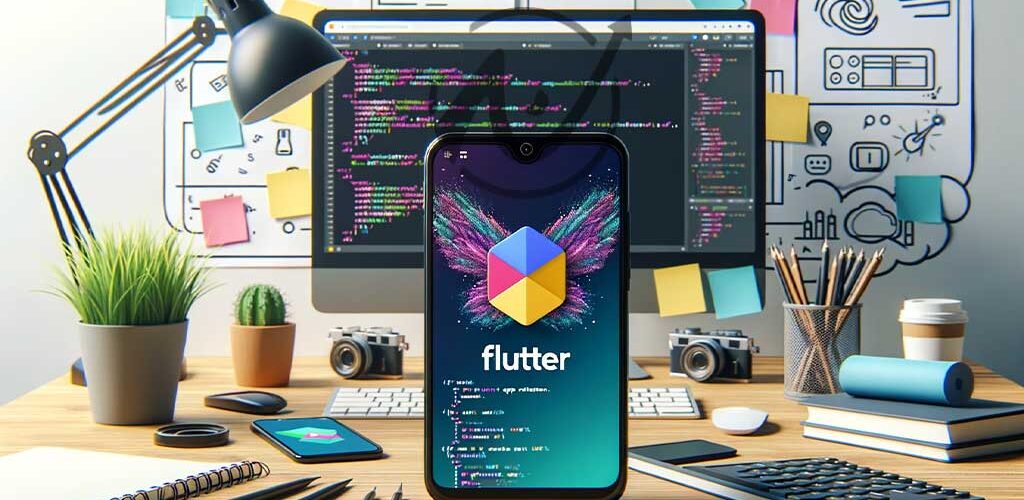This guide assumes you have already installed Flutter and the necessary development tools (e.g., Android Studio or Visual Studio Code with the Flutter extension).
- Open your IDE (Android Studio or Visual Studio Code).
- Create a new Flutter project:
- In Android Studio: Click “File” > “New” > “New Flutter Project.”
- In Visual Studio Code: Press “Ctrl+Shift+P” (Windows/Linux) or “Cmd+Shift+P” (Mac) to open the command palette, then type “Flutter: New Project” and press Enter.
- Enter a project name, like “my_first_flutter_app”, and specify the location where you’d like to save it. Click “Next” (Android Studio) or “Finish” (Visual Studio Code).
- Your new Flutter project will open with a default “counter” app template. Locate the
lib/main.dartfile, which contains the source code for the app. - Replace the content of
main.dartwith the following code:
import 'package:flutter/material.dart';
void main() {
runApp(MyApp());
}
class MyApp extends StatelessWidget {
@override
Widget build(BuildContext context) {
return MaterialApp(
title: 'My First Flutter App',
theme: ThemeData(
primarySwatch: Colors.blue,
),
home: MyHomePage(title: 'Home Page'),
);
}
}
class MyHomePage extends StatefulWidget {
MyHomePage({Key? key, required this.title}) : super(key: key);
final String title;
@override
_MyHomePageState createState() => _MyHomePageState();
}
class _MyHomePageState extends State<MyHomePage> {
@override
Widget build(BuildContext context) {
return Scaffold(
appBar: AppBar(
title: Text(widget.title),
),
body: Center(
child: Column(
mainAxisAlignment: MainAxisAlignment.center,
children: <Widget>[
Text(
'Hello, world!',
style: Theme.of(context).textTheme.headline4,
),
],
),
),
);
}
}
This code defines a simple “Hello, world!” app with an app bar and centered text.
- Save the
main.dartfile. - Run the app:
- In Android Studio: Click the “Run” button (green play icon) in the toolbar.
- In Visual Studio Code: Press “F5” or click “Run” > “Start Debugging” in the top menu.
- The app will build and launch either on an emulator or a connected physical device. You should see the “Hello, world!” text on the screen.
Congratulations, you’ve just created your first Flutter app! You can now start experimenting with widgets, layouts, and other features to build more complex apps.
So, what can be the next step in learning?
Once you’ve created your first Flutter app, it’s time to explore more advanced concepts and learn how to build more complex apps. Here are some next steps to guide your learning journey:
- Study the basics of Dart: Flutter uses Dart as its programming language. Familiarize yourself with Dart’s syntax, data types, control structures, and object-oriented programming concepts. The official Dart documentation is a great place to start: https://dart.dev/guides
- Understand the widget system: Widgets are the building blocks of Flutter apps. Learn about stateless and stateful widgets, and explore the widget catalog to see what’s available: https://flutter.dev/docs/development/ui/widgets
- Learn about layouts: Understand how to create layouts using widgets like Rows, Columns, Containers, and Expanded. This will help you create responsive and visually appealing interfaces: https://flutter.dev/docs/development/ui/layout
- Navigation and routing: Learn how to navigate between different screens (routes) in your app, and how to pass data between them: https://flutter.dev/docs/development/ui/navigation
- State management: As your app grows in complexity, you’ll need to manage the state efficiently. Explore different state management approaches, such as provider, BLoC, or Redux: https://flutter.dev/docs/development/data-and-backend/state-mgmt
- Working with assets and images: Learn how to include and manage assets, such as images and fonts, in your app: https://flutter.dev/docs/development/ui/assets-and-images
- Animations: Understand how to create smooth animations and transitions in your app to enhance the user experience: https://flutter.dev/docs/development/ui/animations
- Networking: Learn how to make network requests and handle responses, typically when interacting with RESTful APIs: https://flutter.dev/docs/development/data-and-backend/networking
- Persistence: Explore ways to store data locally on the device using databases or shared preferences: https://flutter.dev/docs/development/data-and-backend/storage
- Testing and debugging: Get familiar with testing and debugging tools to ensure the quality and stability of your app: https://flutter.dev/docs/testing
- Publishing your app: Learn how to prepare your app for release and publish it on app stores, like Google Play: https://docs.flutter.dev/deployment/android and the App Store: https://docs.flutter.dev/deployment/ios
As you progress, consider building small projects to apply your new skills and reinforce your learning. You can also join Flutter communities, attend meetups, and follow blogs and tutorials to stay up-to-date with the latest trends and best practices. Good luck on your Flutter journey!
Several Interactive Resources and Platforms Where You Can Learn and Practice Flutter Directly:
there are several interactive resources and platforms where you can learn and practice Flutter directly. These resources often include hands-on tutorials, examples, and exercises that can help reinforce your learning.
Here are some popular interactive sources to learn and practice Flutter:
- Flutter’s official documentation: The official Flutter documentation contains many examples, code snippets, and interactive widgets that you can directly use and experiment with. The official website also provides step-by-step codelabs that guide you through building a specific app or feature: https://flutter.dev/docs
- Flutter YouTube channel: Flutter’s official YouTube channel features many useful tutorials, demos, and presentations covering various topics. Some videos include live coding sessions that allow you to follow along and build an app: https://www.youtube.com/channel/UCwXdFgeE9KYzlDdR7TG9cMw
- DartPad: DartPad is an online editor that allows you to write, run, and share Dart and Flutter code directly in your browser. It’s a great way to experiment with code snippets and practice without setting up a local development environment: https://dartpad.dev/
- Udemy: Udemy offers various comprehensive Flutter courses, such as “The Complete 2023 Flutter Development Bootcamp with Dart” by Dr. Angela Yu or “Flutter & Dart – The Complete Guide [2023 Edition]” by Maximilian Schwarzmüller. These courses contain hands-on examples, quizzes, and exercises to help you practice: https://www.udemy.com/
- Codecademy: Codecademy has an interactive course called “Learn Flutter” that covers the basics of Flutter development through hands-on exercises: https://www.codecademy.com/learn/learn-flutter
- Ray Wenderlich: Ray Wenderlich’s website features various tutorials and screencasts on Flutter development. Some tutorials include practical exercises where you build a specific app or feature: https://www.raywenderlich.com/library?domain_ids[]=2
Remember that practice is key to mastering any new skill. As you progress through these resources, try building your own small projects to apply your knowledge and improve your proficiency.

